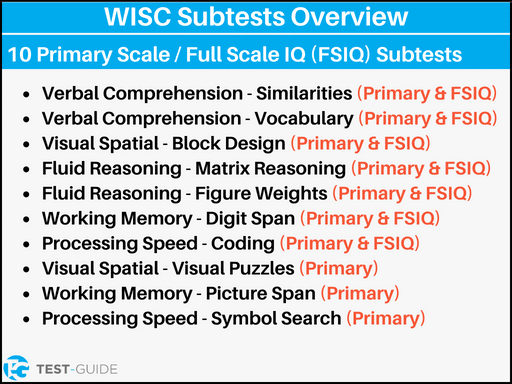WISC-V Practice Test
Take our free WISC-V practice test to prepare for the exam. This practice exam is based on the 7 primary full scale IQ (FSIQ) version of the WISC.
What is the WISC-V Test?
The WISC test is an IQ test that is administered to children between the ages of 6 and 16. It is used to test cognitive ability, cognitive function, and whether or not a child is gifted.
The exam is administered online or paper-and-pencil. The exam is administered individually by a school or trained psychologist. The exam was updated in 2014, with the current version of the exam being the WISC-V.
You can expect the full exam to take between 65 and 85 minutes. Typically, you will take one of these versions of the exam:
- 10 Primary Scale Subtests
- 7 Primary Full Scale IQ (FSIQ)
The version of the exam administered will depend on your school or psychologist.
The test is standardized which means that it has been given to a large group of children and the results have been “normalized.” This helps the exam to be accurate and reliable as you can compare your child’s results to their peers.
The WISC-V has been researched and consistently measures accurate results over time.
Quick Facts:
- Time Limit: 65 to 85 Minutes
- Current Version: WISC-V
- 2 Versions: 10 Primary Scale Subtests or 7 Primary Full Scale IQ (FSIQ)
- Purpose: To Measure Cognitive Ability, Cognitive Function, and Determine if a Child is Gifted.
WISC-V Subtests
There are 16 subtests that can be administered on the WISC test. The number of subtests administered depends on which version of the exam you are given.
The most common versions administered are:
- 10 Primary Scale Subtests
- 7 Primary Full Scale IQ (FSIQ)
The most common subtests on the WISC-V are:
- Verbal Comprehension: Similarities (Primary & FSIQ) – The skill of comparing two things that are related.
- Verbal Comprehension: Vocabulary (Primary & FSIQ) – The ability for your child to give definitions to words
- Visual Spatial: Block Design (Primary & FSIQ) – The ability for your child to use two-color blocks and make the model shown in a picture.
- Fluid Reasoning: Matrix Reasoning (Primary & FSIQ) – The ability for your child to choose from an array of five pictures the one that fits the best in the missing square to complete the photo sequence.
- Fluid Reasoning: Figure Weights (Primary & FSIQ) – The ability for your child to choose the photo that will balance out the scale (while looking at a scale).
- Working Memory: Digit Span (Primary & FSIQ) – The ability for your child to repeat a number sequence that has been read aloud.
- Processing Speed: Coding (Primary & FSIQ) – The ability for your child to copy symbols that match a number code (while using an answer key).
- Visual Spatial: Visual Puzzles (Primary) – The ability for your child to pick one set of three images that make the puzzle in a picture prompt.
- Working Memory: Picture Span (Primary) – The ability for your child to recall photos that were shown earlier.
- Processing Speed: Symbol Search (Primary) – The ability for your child to identify specific symbols in a row of various symbols.

For more information on the other subtests, you can read this official WISC PDF.
Another factor that may determine which subtests your child receives is their age. Several age ranges are tested on the WISC-V test. Check out the next section to discover which IQ exam your child qualifies for.
WISC-V Age Ranges
Understanding the age ranges for the WISC-V can be a little complicated. The first thing you need to know is that there are three tests for various age ranges:
- 6-7 Years: Used for Children in Elementary Education.
- 8-12 Years: Used for Children in Middle School
- 13-16 Years: Used for Children in Late Middle School to Early High School.
If your child is seventeen years old or older, they qualify for the Wechsler Adult Intelligence Scale (WAIS).
When examining the results of your child’s test, their results will be compared to those who scored within a three-month age range.
To see what WISC age range your child fits into, check the table below:
| WISC Age Ranges | ||
|---|---|---|
| 6 yrs. 0 mos. – 6 yrs. 3 mos. | 9 yrs. 8 mos. – 9 yrs. 11 mos. | 13 yrs. 4 mos. – 13 yrs. 7 mos. |
| 6 yrs. 4 mos. – 6 yrs. 7 mos. | 10 yrs. 0 mos. – 10 yrs. 3 mos. | 13 yrs. 8 mos. – 13 yrs. 11 mos. |
| 6 yrs. 8 mos. – 6 yrs. 11 mos. | 10 yrs. 4 mos. – 10 yrs. 7 mos. | 14 yrs. 0 mos. – 14 yrs. 3 mos. |
| 7 yrs. 0 mos. – 7 yrs. 3 mos. | 10 yrs. 8 mos. – 10 yrs. 11 mos. | 14 yrs. 4 mos. – 14 yrs. 7 mos. |
| 7 yrs. 4 mos. – 7 yrs. 7 mos. | 11 yrs. 0 mos. – 11 yrs. 3 mos. | 14 yrs. 8 mos. – 14 yrs. 11 mos. |
| 7 yrs. 8 mos. – 7 yrs. 11 mos. | 11 yrs. 4 mos. – 11 yrs. 7 mos. | 15 yrs. 0 mos. – 15 yrs. 3 mos. |
| 8 yrs. 0 mos. – 8 yrs. 3 mos. | 11 yrs. 8 mos. – 11 yrs. 11 mos. | 15 yrs. 4 mos. – 15 yrs. 7 mos. |
| 8 yrs. 4 mos. – 8 yrs. 7 mos. | 12 yrs. 0 mos. – 12 yrs. 3 mos. | 15 yrs. 8 mos. – 15 yrs. 11 mos. |
| 8 yrs. 8 mos. – 8 yrs. 11 mos. | 12 yrs. 4 mos. – 12 yrs. 7 mos. | 16 yrs. 0 mos. – 16 yrs. 3 mos. |
| 9 yrs. 0 mos. – 9 yrs. 3 mos. | 12 yrs. 8 mos. – 12 yrs. 11 mos. | 16 yrs. 4 mos. – 16 yrs. 7 mos. |
| 9 yrs. 4 mos. – 9 yrs. 7 mos. | 13 yrs. 0 mos. – 13 yrs. 3 mos. | 16 yrs. 8 mos. – 16 yrs. 11 mos. |
WISC-V Scoring
As mentioned above, your score is compared to others who are in your age range (3-month).
All age bands are standardized and used to calculate your child’s IQ score. The scores are not based on the percentage of questions answered correctly. WISC scores are based on your child’s score compared to the other standardized sample of children in their age group.
Here are the standard score ranges for the WISC test:
| Score Range | Description |
|---|---|
| 70-79 | Borderline |
| 80-89 | Low Average |
| 90-109 | Average |
| 110-119 | High Average |
| 120-129 | Above Average |
| 130-145 | Moderately Gifted |
| 146-159 | Highly Gifted |
How to Study for the WISC-V Test
Since the WISC-V exam is used as an intelligence test for children, there is not a set way you can study for this exam. Parents are encouraged to let their children prepare “naturally” by using the following tips:
- Read With Your Child: Reading is a great way to expand your child’s vocabulary. They will be exposed to new words and situations when reading. Make a special point to ask them if they know what certain words mean while reading (active reading).
- Brain Games: If you want to give your child some exposure to questions or similar exercises that they might see on the WISC, you can practice fun brain games. A great example would be taking our WISC practice test above. Make sure to phrase it as a “game” when explaining to your child what they are doing (this makes it more fun for them and less stressful).
- Raise their Curiosity: Ask your children questions and encourage their curiosity. Curiosity is a great way for kids to learn and should always be encouraged.
Frequently Asked Questions
What is a good WISC score?
A score of 146-159 is considered “highly gifted.” Any score above 120 is considered “above average.” A score from 90-109 is considered “average.”
What is the WISC and what does it measure?
The WISC exam is a children’s intelligence test that measures the IQ and giftedness of a child.
How accurate is WISC test?
As the WISC has changed over the years, it has become more comprehensive and accurate, so the WISC-V is considered very accurate. It is standardized and compares scores for children across similar age bands.
What is the most current version of the exam?
The WISC-V is the most current version of the exam. It was released in 2014.

